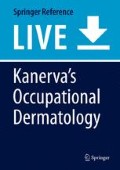Abstract
Many intrinsic and extrinsic factors affect percutaneous absorption rates.
Percutaneous absorption is measured in vivo through different methods, including radioactivity measurements in the blood and excreta, surface recovery, surface disappearance, biological and pharmacological responses, the stripping method, and human-skin-flap method.
In vitro methods include measuring absorption rates through excised skin into a receptacle designed to mimic actual dermatological conditions.
Measuring the radioactivity in a subject’s blood and excreta is commonly practiced, and involves administering a compound often radiolabeled, in order to measure the amount of the original dose that has penetrated the skin.
Surface recovery and disappearance methods involve administering a compound on the skin and measuring the rate of recovery from the surface of the skin or the rate of its disappearance.
The stripping method deals with measuring the concentration of a chemical in the stratum corneum through successive tape applications and removals.
Efforts are being made to standardize the most commonly used in vitro assay.
The vehicle by which a compound is transferred to the skin has an effect on its absorption rate.
References
Arpaia P, Cesaro U, Moccaldi N (2017) Noninvasive measurement of transdermal drug delivery by impedance spectroscopy. Sci Rep 7:44657
Chan HP, Zhai H, Hui X, Maibach HI (2012) Skin decontamination. Toxicol Ind Health 29(10):955–968
Clarke JF, Cordery SF, Morgan NA et al (2015) In vitro method to quantify dermal absorption of pesticide residues. Chem Res Toxicol 28(2):166–168
Dancik Y, Bigliardi PL, Biglairdi-Qi M (2015) What happens in the skin? Integrating skin permeation kinetics into studies of developmental and reproductive toxicity following topical exposure. Reprod Toxicol 58:252–281
EFSA (2012) European food safety authority panel on plant protection products and their residues. Scientific opinion – guidance on dermal absorption. EFSA J 10:1–30
Herbig ME, Houdek P, Gorissen S, Zorn-Kruppa M, Wladykowski E, Volksdorf T, Grzybowski S, Kolios G, Willers C, Mallwitz H, Moll I, Brandner JM (2015) A custom tailored model to investigate skin penetration in porcine skin and its comparison with human skin. Eur J Pharm Biopharm 95:99–109
Hui X, Lamel S, Qiao P, Maibach HI (2013) Isolated human/animal stratum corneum as a partial model for 15 steps in percutaneous absorption: emphasizing decontamination, Part I. J Appl Toxicol 33(3):157–172
Jung EC, Maibach HI (2015) Animal models for percutaneous absorption. J Appl Toxicol 35:1–10
Lehman PA, Raney SF, Franz TJ (2011) Percutaneous absorption in man: in vitro-in vivo correlation. Skin Pharmacol Physiol 24:224–230
Maibach H, Patrick E (2001) Chap 22, Dermatotoxicology. In: Hayes AW (ed) Principles and methods of toxicology. Taylor and Francis, Philadelphia, pp 1039–1084
NAFTA (2008) Dermal absorption group position paper on use of in vitro dermal absorption data in risk assessment. Unpublished; available upon request: North American Free Trade Agreement Dermal Absorption Working Group, 1–3
Ngo M, Maibach H (2012) Chap 6, 15 Factor of percutaneous penetration of pesticides. In: Knaak JB, Thimchalk C, Tornero-Velez R (eds) Parameters for pesticide QSAR and PBPK/PD models for human risk assessment. American Chemical Society, Washington, DC, pp 67–86
Phuong C, Maibach HI (2016) Effect of massage on percutaneous penetration and skin decontamination: man and animal. Cutan Ocul Toxicol:1–4
Planz V, Lehr C-M, Windbergs M (2016) In vitro models for evaluating safety and efficacy of novel technologies for skin drug delivery. J Control Rel 242:89–104
Rougier A, Dupuis D, Lotte C, Maibach HI (2002) Chap 16, Stripping method for measuring percutaneous absorption in vivo. In: Bronaugh RL, Maibach HI (eds) Topical absorption of dermatological products. Marcel Dekker, New York, pp 241–245
Sugino M, Hatanaka T, Todo H, Mashimo Y et al (2017) Safety evaluation of dermal exposure to phthalates: metabolism-dependent percutaneous absorption. Toxicol Appl Pharmacol 328:10–17
Ternullo S, de Weerd L, Flaten GE, Holsæter AM, Škalko-Basnet N (2016) The isolated perfused human skin flap model: a missing link in skin penetration studies? Eur J Pharm 96:334–341
Wester RC, Maibach HI (2001) Chap 7, Principles and practice of percutaneous absorption. In: Barel AO, Paye M, Maibach HI (eds) Handbook of cosmetic science and technology. Marcel Dekker, New York, pp 53–59. Part 3: Safety considerations
Wester RC, Maibach HI (2002) Chap 9, In vivo methods for percutaneous absorption measurement. In: Bronaugh RL, Maibach HI (eds) Topical absorption of dermatological products. Marcel Dekker, New York, pp 145–149
WHO (2006) Dermal absorption, in Environmental Health Criteria. Geneva, Switzerland. ISBN 92-4-157235
Zhu H, Jung EC, Phuong C et al (2015) Effects of soap-water wash on human epidermal penetration. J Appl Toxicol 36(8):997–1002
Author information
Authors and Affiliations
Corresponding author
Editor information
Editors and Affiliations
Rights and permissions
Copyright information
© 2018 Springer International Publishing AG, part of Springer Nature
About this entry
Cite this entry
Jiang, A., Maibach, H.I., Wiener, A., Reddy, R. (2018). Percutaneous Penetration. In: John, S., Johansen, J., Rustemeyer, T., Elsner, P., Maibach, H. (eds) Kanerva’s Occupational Dermatology. Springer, Cham. https://doi.org/10.1007/978-3-319-40221-5_2-2
Download citation
DOI: https://doi.org/10.1007/978-3-319-40221-5_2-2
Received:
Accepted:
Published:
Publisher Name: Springer, Cham
Print ISBN: 978-3-319-40221-5
Online ISBN: 978-3-319-40221-5
eBook Packages: Springer Reference MedicineReference Module Medicine

